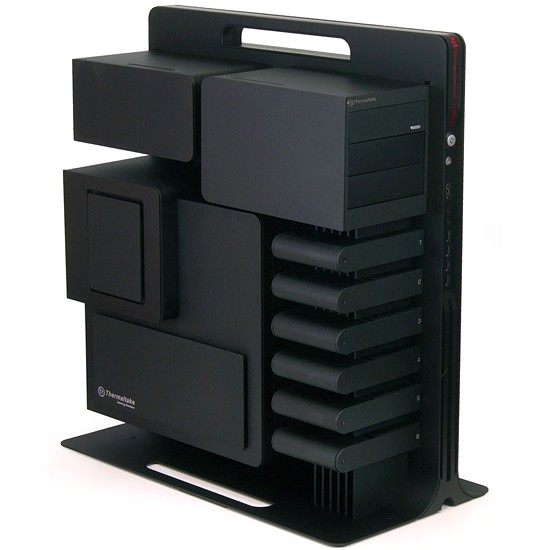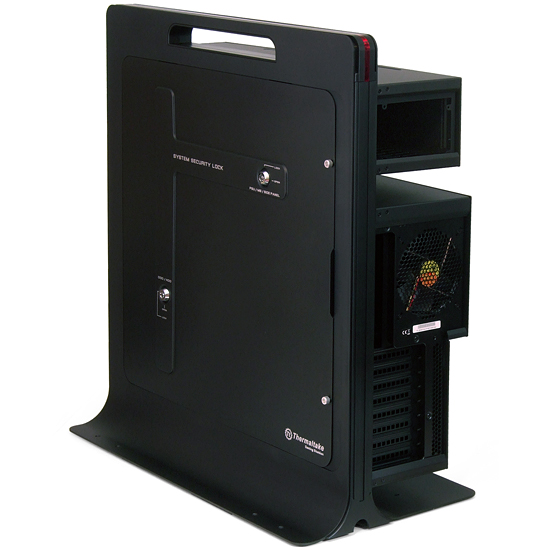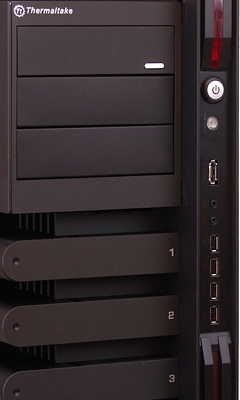Thermaltake Level 10 And SilverStone Fortress 2: Contemporary Cases?
Thermaltake Level 10
Based heavily on an award-winning design from BMW DesignworksUSA, Thermaltake’s Level 10 Gaming Station differs mostly in its lower-cost finish and production methods. Gone are the polished paint and die-stamped end caps, which are replaced with a flat finish and precision-cut aluminum plates. Remaining curved edges have been pressed in two dimensions rather than three, completely eliminating the need for expensive forming dies. These lower-cost design elements are probably reasonable compromises to keep this low-volume product under $1,000.
Now would be a good time to point out the Level 10’s potential as a high-end workstation housing, particularly in design studios where outward appearances can give one firm the leg-up over a competitor whose work might be just as good. Workstation-size hardware easily fits, while the design can support motherboards as large as the EATX form factor. It also has an eight-position slot panel that could easily hold four graphics cards for the ultimate in Tesla Personal Supercomputer number-crunching power.
This is also where we call into question the Game Station theme, since gamers typically put function over form. Though the case will hold four-way SLI and CrossFire solutions, it will not hold the large liquid-cooling systems that many less-expensive products eagerly accept. Overclockers are thus confined to the limits of air cooling, since the tiny all-in-one liquid coolers that do fit cannot match the cooling prowess of “big air.”
Twin locks on the back and a bolt-ready flange on the bottom make the Level 10 appear secure enough for placement in publicly accessible areas, but the lack of any front-panel access keys means that local data security can only be accomplished via software. Power and reset buttons and connections for eSATA, a headphone, a microphone, and four USB ports are within easy reach of the user.
Get Tom's Hardware's best news and in-depth reviews, straight to your inbox.
Current page: Thermaltake Level 10
Prev Page Building With The Fortress 2 Next Page Opening The Level 10-
burnley14 I like the Fortress 2, especially the 90 degree rotation from typical setup. The Level 10, on the other hand, is an ugly monstrosity. Anyone willing to pay $700 for something that ugly needs therapy.Reply -
philologos The Fortress 2 is very likely the case for my first home-build. It's a bit more than I'd like to spend, but it satisfies my need for air-cooling performance and classic styling.Reply -
Crashman burnley14I like the Fortress 2, especially the 90 degree rotation from typical setup. The Level 10, on the other hand, is an ugly monstrosity. Anyone willing to pay $700 for something that ugly needs therapy.Reply
I just saw a girl driving a rusted-out Mazda with a new set of 18" Enkeis, painted rotors on the front, and painted drums on the back. The rocker panels between that fine work...rusted away!
So, I'm sure someone will spend $700 for the Thermaltake Level 10. In fact, I know someone who would. -
I recently bought à fortress case for my most recent build (i930 + hd5970) and this is by far THE best case i've ever had the pleasure of building a pc from/in. Yeah it's pricy and wether it's worth it, but personally, i really, really like it! It cools very wel, and the very large 5970 actually fits :)Reply
and irl it's quite a handsome case! -
mados123 The Level 10 deserves to be in MOMA next to the G4 cube for its innovation in design.Reply -
micr0be i think level 10 is a amazing .... just replace some side windows with glass and uv got a rig that looks as good as crysis .....Reply -
huron As amazing as it is, I'm sure there will be some people shelling out that kind of $$$ on a case - probably the same people who post in the forums that they have a budget upwards of $3500 and want someone to build it for them...Reply -
warmon6 while i like the look of the level 10 case, i dont like the high price tag that comes with it.Reply -
acadia11 The cost savings made no sense, to me, in the Level 10, keeping it under $1000 is stupid, to someone spending $799 on a case, makes no difference if it cost $999 for a more quality product. In fact, people, who are willing to spend money like this care more about quality than cost. I decided not to get the case, because, in my mind $800 on a case alone better buy me perfection, and they tried to get cheap with it to save a couple of hundred bucks, as though the difference between $800 and $1000 really mattered that much to my wallet, Imean it's not like cases normally hover anywhere in this price range. With an expensive uber product you set themarket, period. And they dropped the ball on knowing the demographics here.Reply



